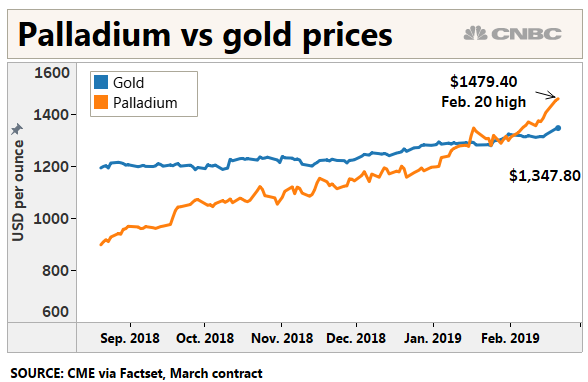Palladium is outshining other metals due to tight supply and strong demand from the global auto industry, which needs increasing amounts of the metal to meet stricter emissions standards.
The metals market, in general, has gotten a boost of bullishness on hopes for a trade deal and expectations that China's economic stimulus is going to help the world economy.
Palladium hit a record in the spot market Wednesday, when it briefly crossed $1,500 per ounce. Palladium futures for March briefly touched $1,479 per ounce.
"It's commanding right now a 120 or so premium to gold, and it's also something like 1.8 times the price of platinum, so it does look very high. The problem is it's never been up here before. We're in new territory and it has a sort of sentiment, attracting a large investment element right now, which may have pushed the price away from equilibrium," said James Steel, precious metals analyst at HSBC. "This market has been strong for many quarters and it is operating under a production deficit."
Palladium futures are up 22 percent since the beginning of the year, double the move in copper and four times the move in gold. Gold futures were trading at about $1,350 per ounce Wednesday.
Citigroup analysts this week said they are bullish on metals, but particularly so for copper, palladium, iron ore and zinc. They expect 8 percent to 15 percent upside over the next three to six months.
"We see the 'macro' and 'micro' combining to drive outperformance in these markets, while broader commodities may rise albeit to a lesser degree on an anticipated improvement in macroeconomic sentiment. Major downside risks to our view are that Trump levies further new trade tariffs on China or a hard Brexit occurs," wrote the Citigroup analysts.
Palladium is used in catalytic converters, which are a part of auto exhaust systems. Standard Chartered analyst Suki Cooper said world wide auto makers are seeing stricter emissions standards, increasing the demand for the exhaust control devices and therefore, the precious metal. In 2018, 8.7 million ounces of palladium out of a 10 million ounce market went to the auto industry, she said.

"We would expect to see some correction, some profit-taking along the way," said Cooper. But with palladium producers unable to add capacity for several years, the market will be tight and the trend for prices is higher.
"We are forecasting partial deficits for the next couple of years," she said. "There is limited supply growth. The demand side is still robust even though we've been seeing slowing auto sales in China and the U.S. It's the environmental regulations that had a much larger impact on overall demand."
There currently is no real, easy replacement for the palladium, 75 percent of which is mined in Russia and South Africa. Cooper said even though car sales are slowing, emissions laws are getting stricter all over the world. Drivers have also been moving away from diesel fuel to gasoline cars, which require more palladium. Electric vehicles do not use palladium but hybrids do, analysts said.
Steel said it's conceivable platinum could take the place of some palladium. "It would take several years. The two metals are in the same group,...but the two do act differently at different temperatures," he said.
Cooper said average palladium loadings have risen globally, even as auto sales have dipped, often a sign of weaker demand for palladium. " From an auto manufacturing standpoint, they need to meet the standards. First and foremost they need their cars to be compliant. Then they look for cost savings." she said.
Analysts say the market was helped by the fact that ETFs that held the metal were liquidated by investors who made large profits over the years. "Part of the tightness was alleviated in 2018 because there was all of these ETF outflows and some producers released stocks," she said. One of those ETFs is Aberdeen Standard Physical Palladium Shares ETF PALL.
But ETFs now hold just 700,000 ounces after releasing more than 2 million ounces over the past several years, she said. "You could see more ETF redemptions," she added.
from Top News & Analysis https://ift.tt/2X9b6pj
No comments:
Post a Comment